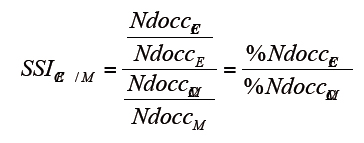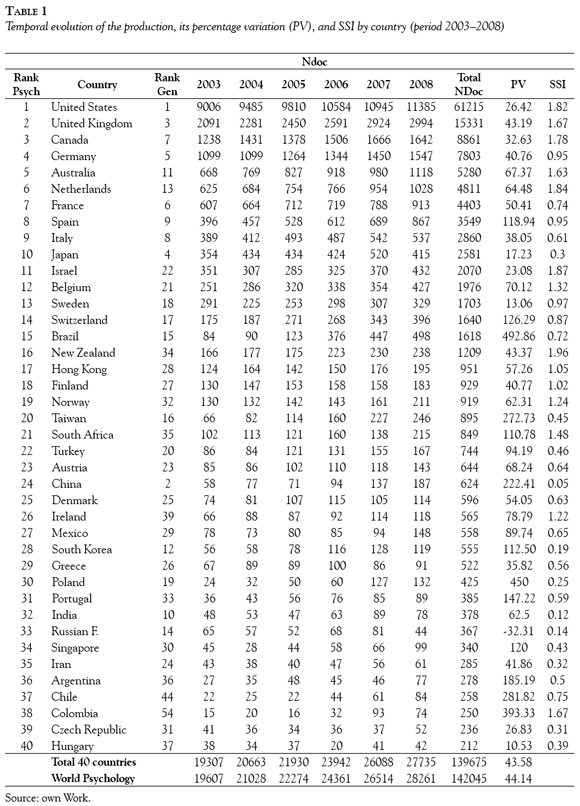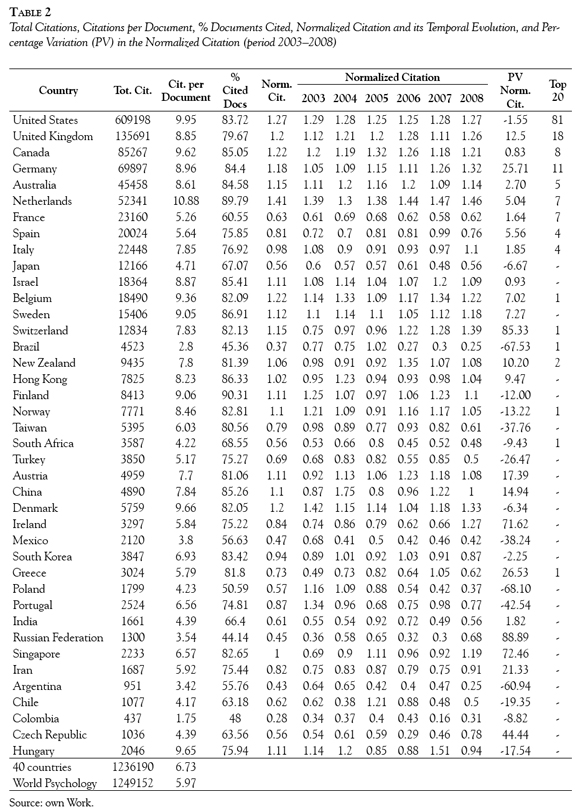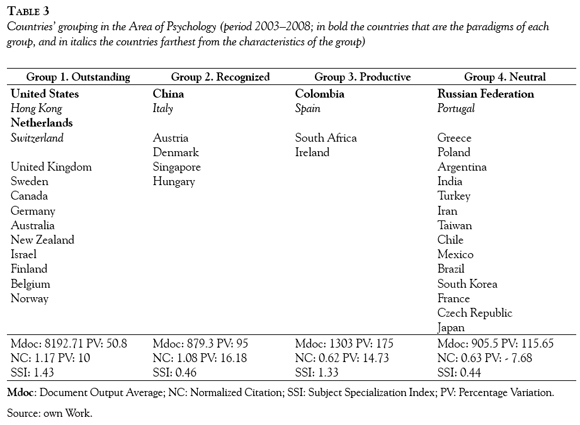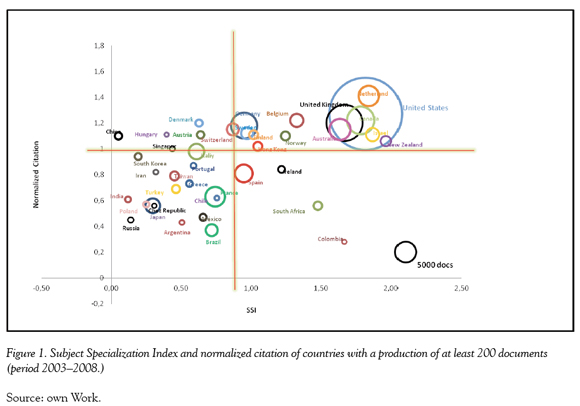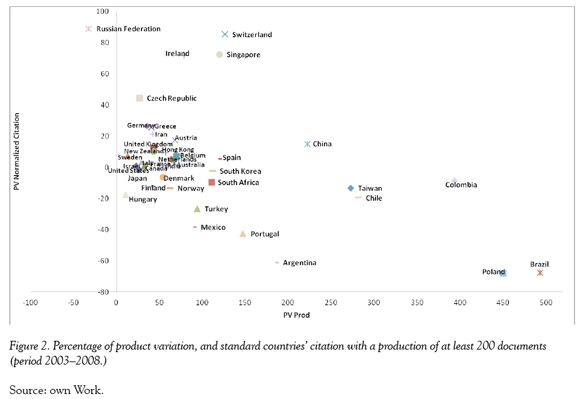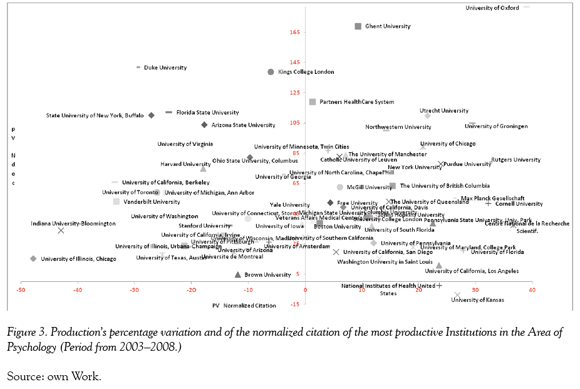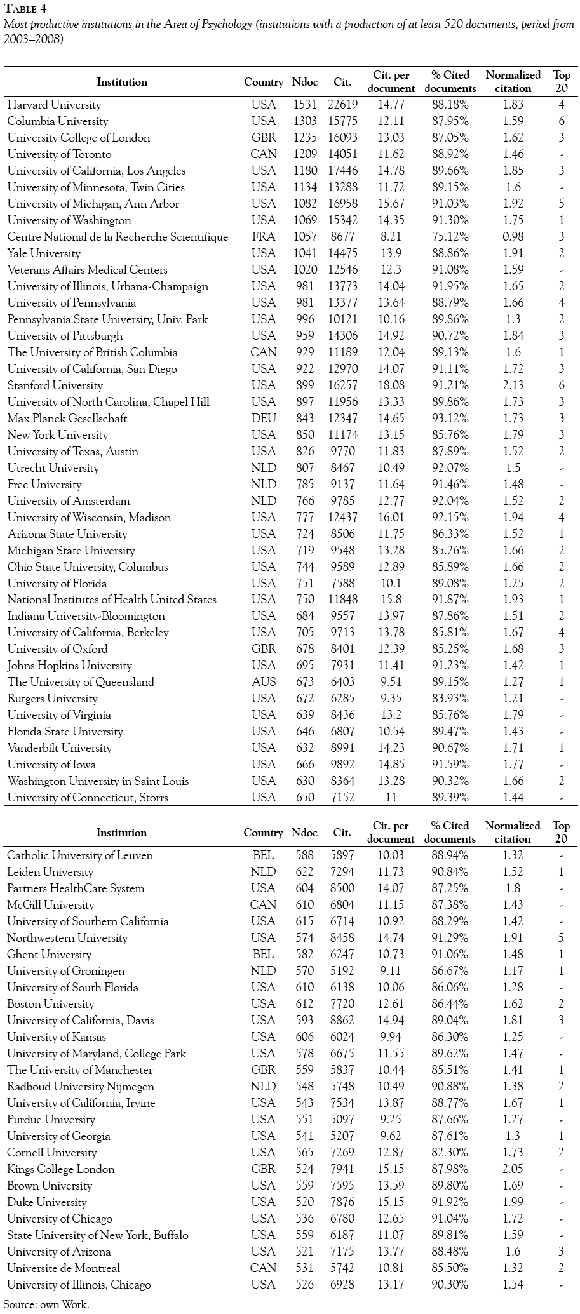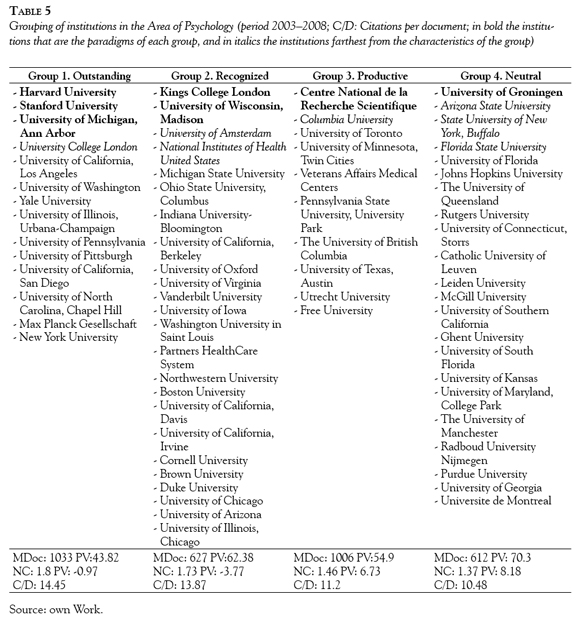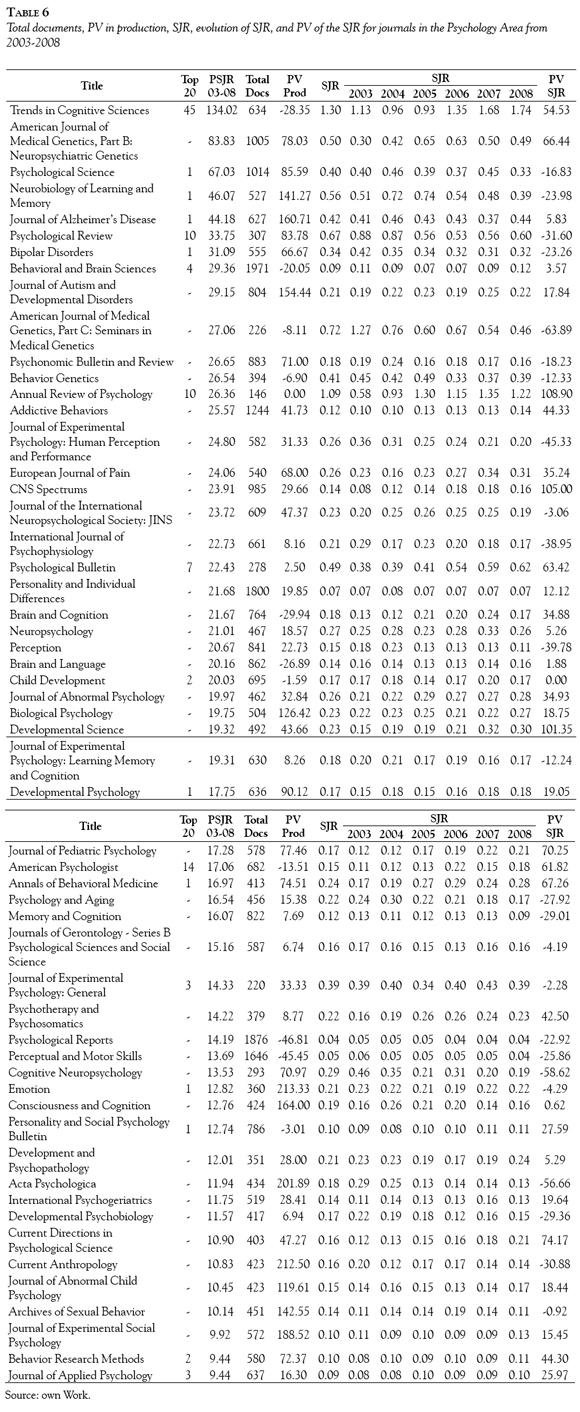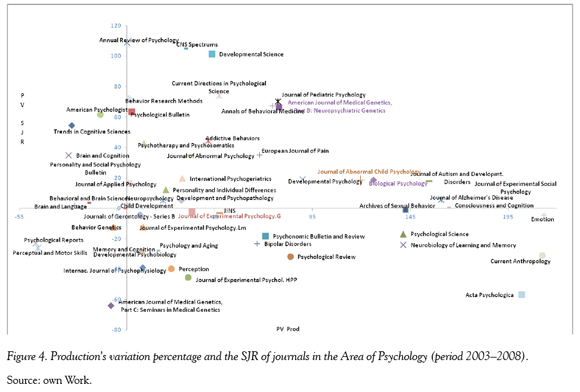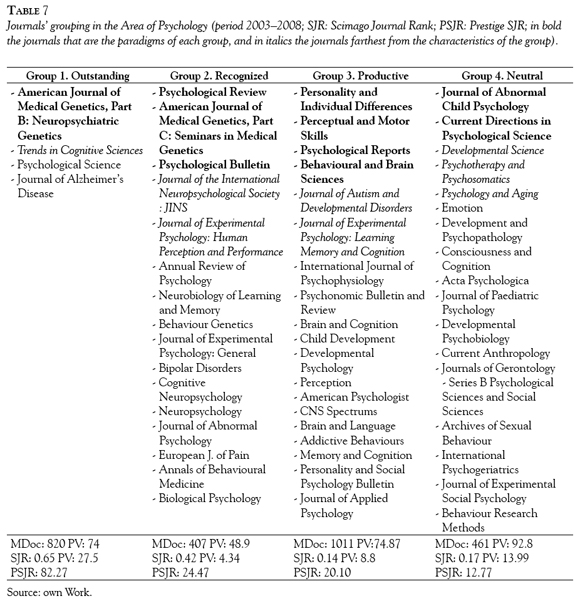Services on Demand
Journal
Article
Indicators
-
 Cited by SciELO
Cited by SciELO -
 Access statistics
Access statistics
Related links
-
 Cited by Google
Cited by Google -
 Similars in
SciELO
Similars in
SciELO -
 Similars in Google
Similars in Google
Share
Universitas Psychologica
Print version ISSN 1657-9267
Univ. Psychol. vol.11 no.3 Bogotá Sept./Dec. 2012
World Scientific Production in Psychology*
Producción Científica de Psicología a nivel mundial
Ana Teresa García-Martínez **
Vicente P. Guerrero-Bote ***
Felix de Moya-Anegón ****
* This work was financed by the Plan Nacional de Investigación Científica, Desarrollo e Innovación Tecnológica 2008-2011 and the Fondo Europeo de Desarrollo Regional (FEDER), as a part of research projects research TIN2008-06514-C02-01, and TIN2008-06514-C02-02.
** Departamento de Información y Comunicación. Plazuela Ibn Marwan s/n, 06001 Badajoz (España). Teléfono +34 924 286435, fax: +34 924 286401; Email: atmar@alcazaba.unex.es
*** Universidad de Extremadura, España, Departamento de Información y Comunicación. Email: vicente@alcazaba.unex.es
**** Grupo Scimago, CSIC, CCHS, IPP, Madrid, España, Email: felix.moya@scimago.es ResearcherID: Moya-Anegón, F. C-4004-2009
Recibido: mayo 1 de 2012 | Revisado: junio 1 de 2012 | Aceptado: junio 15 de 2012
Para citar este artículo.
García-Martínez, A. T., Guerrero-Bote, V. & Moya-Anegón, F. (2012). World Scientific Production in Psychology. Universitas Psychologica, 11 (3), 699-717.
Abstract
This study examines world scientific production in Psychology based on bibliometric indicators (scientific production, production's percentage variation, average citations per document, normalized citation, impact, etc.), for the period 2003-2008. The analysis is made by country, by research institutions, and scientific journals, using the Scopus (Elsevier), database of scientific literature. The results show that total world production has increased over the period studied. Four groups are acknowledge for each country, institutions, and journals, taking into account their values of scientific production, normalized citation, and subject specialization.
Key words authors: Global Psychology, Scientific Production, Bibliometrics.
Key words plus: Scientometrics, Journals Psychology, Elsevier.
SICI: 1657-9267(201209)11:3<699:WSCIPP>2.0.TX;2-L
Resumen
Este estudio examina la producción científica mundial en psicología sobre la base de indicadores bibliométricos (producción científica, variación en los porcentajes de producción, promedio de citaciones por documento, impacto, etc.) para el periodo 2003-2008. El análisis se realiza por país, por instituciones de investigación y por revistas científicas, usando la base de datos de literatura científica Scopus (Elsevier). Los resultados muestran que la producción mundial total se ha incrementado durante el periodo estudiado. Se distinguen cuatro grupos de cada país, instituciones y revistas, basados sobre los valores de producción científica, citación normalizada y área de especialización.
Palabras clave autores: Psicología mundial, producción científica, bibliometría.
Palabras clave descriptores: Cienciometría, revistas de psicología, Elsevier.
In the 1970s, it was possible to observe an incipient interest in the analysis of scientific productivity in the field of Psychology, as evidenced by Endler, Rushton, & Roediger (1978), Levin et al. (1978), and Daniel (1979), apart from the analyses that E. Garfield published in Current Contents from 1975 until the 1990s.
However, it was not until the beginning of this century that there was really a major interest in the analysis of scientific research in general. This was due, in addition to the traditional interest in the field of science's history, to policy-makers' need to evaluate the growing production of researchers, and the researchers' own desire to see where they were positioned in their specialization. Following Hj0rland (2002), there have been different approaches to these studies. One of them is represented by psychology's traditional historiography done in Italy by Ceccarelli et al. (2010), and the other by Hj0rland's (1998) own epistemological and critical studies. But perhaps the mainstream approach in the field in the present day is the use of bibliometric methods to study structures and institutions in scientific communication. For example: Haggbloom et al. (2002), apply citation analysis to determine which have been the eminent authors in Psychology; López, García-Cepero, Bustamante-Aguilar, Silva & López (2010), examine the patterns of behavior of authors publishing in Psychology In Latin America; Ribas et al. (2009), study the authors in Social Psychology In Brazil to reveal the salient topics in this category; and Jevremov, Pajic, & Sipka (2007), consider the intellectual structure of Personality Psychology's specialization based on author co-citation.
Other studies have been clearly delimited geographically by having a focus of a country's particular national context. Liberatore and Hermosilla (2008), deal with the volume, visibility, and impact of the scientific production on Psychology In Argentina. Pfrang and Schneider (2006), make a comparative study of the situation of German Psychology in relation to other countries in Europe, and Hadjistavropoulos (2009), a similar comparison of the impact of Canadian Psychology with respect to other G8 countries. García Pérez (2001), and De Tejada and Tedó (2001), address psychological research in Spain distinguishing by specialization, and García Martínez et al. (2008a, 2008b, 2009), consider the same topic in Spain and Latin America. Shortening the context even further, Krampen (2008), evaluate university Psychology Departments based on citation analysis, and Mahoney, Buboltz, Calvert, & Hoffmann (2010), give an overview of the production of Psychology's institutions through a publication's analysis in journals of the American Psychology Association. Globally speaking, Navarrete-Cortes, Fernández-López, López-Baena, Quevedo-Blasco, and Buela-Casal (2010), describes a countries' qualification according to their impact and scientific output in Psychology journals including the Web of Science.
Therefore most of these scientometric studies have been limited to a subdiscipline of psychology, or to a particular country or region, and does not deal with the subject area as a whole. They also take restricted methodological approaches in both the data retrieval strategy, and the indicators' calculation.
In this work, we analyze scientific production in the Area of Psychology using bibliometric indicators (production, normalized citation, and their percentage variations, the Subject Specialization Index, citations per document, SJR, excellence, etc.), for the period 2003-2008. As independent variables, we consider countries, major research institutions, and scientific journals.
Material and Methods
In November 2004, the largest multidisciplinary scientific bibliographic database on the market, Scopus, was made available with more than 17 000 journals' coverage (Hane, 2004; Pickering, 2004). Despite its short time on the market, this product has already been the object of several studies addressing its characterization and analysis (Archambault, Campbell, Gingras, & Larivière, 2009; Leydesdorff, Moya Anegón, & Guerrero Bote, 2010; Moya Anegón et al., 2007). In the present work, we use the Scimago Institutions Rankings (SIR) resource, a Scopus-based science evaluation tool to assess universities and research-focused institutions (government agencies, research laboratories, hospitals, etc. See http://www.scimagoir.com/methodology.php), to study those countries and institutions with a production (Ndoc), of at least 200 and 520 documents, respectively, and journals in the subject area of Psychology.
The SJR (Scimago Journal Rank), index was developed by the SCImago research group1 to represent the visibility of the journals contained in Scopus since 1996 (González Pereira, Guerrero Bote, & Moya Anegón, 2010; Bollen et al., 2009). It's based on the diffusion of prestige or influence from journal to journal, through references. It is size-independent, and weights the citations received by the journals within a three-year window with the privileged of the cited journal.
The Normalized Citation scores are the scientific impact measures that institutions have on the scientific community as a whole. In order to obtain a fair measurement of this impact, their calculation removes the influence due to the institutions' sizes and research profiles, making it ideal for comparing research performance. The Normalized Impact values are the ratios between an institution's average scientific impact, and the world publications' average impact with the same time frame, document type, and subject area.
Prestige SJR (PSJR), reflects the prestige of entire journals (González Pereira et al., 2010). The Percentage Variation of Production (PVP), for the period studied (2003-2008) is the difference percentage in the number of works in 2008 relative to the total production of 2003.
The Percentage Variation of the Normalized Citations (PVNC) for the period studied (2003-2008) is the percentage difference of the normalized citations in 2008 in relation to the total normalized citations of 2003.
The Subject Specialization Index (SSI), reflects the concerned activity (Moya Anegón et al., 2004), in a particular subject area determined through the level of specialization, understanding it as the relative effort that a community, or agent devotes to a
discipline or subject area. It is quantified in terms of documents' numbers produced in a particular discipline by a given group regarding another. The SSI of subject area C for group E, regarding group M, is calculated as:
Where
- NdoccCE is the number of documents in the field C in the group E (and analogously for NdoccCM);
- NdoccE is the total number of documents of group E (and analogously for NdoccM);
- %NdoccCE is the percentage of documents of group E in the field C relative to the total of that group's primary documents (and analogously for %NdoccCM).
We selected the twenty most cited papers in each of the study period years as works of excellence. This allowed us to calculate an indicator of excellence that we named Top20, for each of these years.
Results
Countries
Of the 230 worldwide countries publishing in all subjects, 69% do so in the field of Psychology, 159 of these, we selected the 40 most productive in the period 2003-2008. Particularly these countries produced more than 200 papers in this period - the position at which there was a clear gap in output with the following country. These 40 countries (representing 17.39% of the total), published 98.33% of all documents produced in the period 2003-2008, with the remaining 1.67% distributed among the 119 countries that weren't included in the selection.
Table 1 presents the production data and its evolution and variation over the covered time period, the subject specialization's level of the forty countries, and their overall world ranking compared to their ranking in Psychology. For example, is clear to observe that the U.S. is ranked number one, both in overall scientific production and in Psychology, representing 43% of worldwide psychological output. But this is not the case with the world's overall number two: China, which ranks only number 24 in Psychology, due to its low subject specialization index. The U.K. is world's overall number three, and second ranked in Psychology, consistent to its high subject specialization index. The same is also the case for Australia and The Netherlands, which present a noticeable advance in ranking in Psychology, in relation to their overall positions.
All the countries except Russia show fairly large growth in this period. The U.S. is the largest producer and continues to grow throughout this period. It is followed by the U.K. but with a gap of 75%, and then by Canada with a bigger gap of almost 50% of the U.K.'s production. From this point onwards, the differences between countries are less seen.
Israel and New Zealand are the two countries with the largest Psychology's specialization, despite ranking only 11 and 16 respectively in production. China, India, and Russia, are the countries with least specializations.
Regarding the production's variation, there are 25 countries above both the global average in Psychology, and the mean for these 40 most productive countries. This group does not include the countries that are already the most productive such as the U.S., U.K., or Canada. The countries with greatest growth in the period are Brazil, Poland, and Colombia despite they didn't ranked near the top of production. This is especially noticeable for Colombia, which is ranked second to last in production.
Table 2 presents the citation data, with each country's score on the total data citations, citations per document, and percentage of cited documents, and the evolution of the normalized citation and its percentage variation over the study period.
Of the total citations (1 249 152), received by the area of Psychology in this period, 98.96% correspond to the 40 most productive countries. The countries receiving most citations are the U.S. with 49.28% total, followed at a distance by the U.K. with 10.97%. From this point on, the distribution of citations is more homogeneous.
The citations per document index of the forty countries (6.86), is above the Psychology world average in this period, but slightly below the general world average.
The meant normalized citation for the 40 countries (0.89) is clearly above the Psychology world average (0.79), but only slightly greater than the general world average (0.87). 22 countries in total surpass the general world average, and 26 the Psychology world average, with the Netherlands, U.S., Canada, Belgium, and the U.K. exceeding it by 50%.
We established four groups of countries according to their production's values, subject specialization, normalized citation, and the percentage variation of these last two indicators (Table 3).
Group 1, of fourteen countries, is characterized by a high production of documents (the meant number of documents exceeds the world meant for Psychology), normalized high citation, and high specialization index. The ranking of these countries in Psychology is higher than their general ranking, with the exception of U.S., which is top-ranked in both. In Figure 1, this group is in the upper right quadrant. Represents the most prominent countries in Psychology's production, it includes the two most specialized countries in the world (New Zealand and Israel), and accounts for 62.5% of the countries with works of excellence. The Netherlands, U.S., Canada, and Belgium, are the countries with the highest values of normalized citation, and the group also includes the countries with the highest percentages of cited documents (Finland, Netherlands, Sweden, and Hong Kong), and two of the countries with the highest number of citations per document (Netherlands, U.S.) This group accounts for 82.11% of the total Psychology's production, and received 88.69% of the total citations.
Group 2 is represented by six countries with normalized high citation index, but low subject specialization and production, except for Italy in this last indicator. In these cases, their ranking in Psychology is lower than their general ranking, with China being the clearest example (Austria and Denmark maintain their respective positions in the two rankings). This group is located in the upper left quadrant of Figure 1. These countries are recognized for their work quality, although they do not produce much in Psychology in relation to their total output. China is the paradigm of this group, and Italy is the only country with an index of excellence, and thus represents just 6.25% of the countries with works of excellence. The group includes two of the countries with most citations per document (Denmark and Hungary). It accounts for 3.77% of the total in Psychology's production, and received 3.42% of the total citations.
Group 3 comprises just four countries, with low normalized citations and high specialization.
Although their production is generally low, Spain's production is very high. All four countries advance in ranking in Psychology relative to their general rankings. This group is located in the lower right quadrant of Figure 1. These countries have a major subject specialization in Psychology, but little recognition. Colombia is the best example, and is also notable for its increase in production (see Figure 2). Spain and South Africa both have indices of excellence, thus representing 12.5% of the total of countries with works of excellence. The group accounts for 3.73% of the total in Psychology's production, and received 2.21% of the total citations.
Group 4 is the largest, comprising 16 countries with low normalized citations and subject specialization. Generally they also have low production, although France, Brazil, and Japan are exceptions in this case. In general the ranking of these countries in Psychology is lower than their general ranking, the exceptions are Portugal, Mexico, and Chile, which advance in positions, and Argentina and Brazil that maintain theirs. This group is located in the lower left quadrant of Figure 1. These countries are neither specialized nor widely recognized. Although their absolute production is low, Brazil and Poland stand out for their growth in production (Figure 2.) France, Brazil, and Greece have contents of excellence in index, thus representing 18.75% of the countries with works of excellence. This group accounts for 10.37% of the total in Psychology's production, and received 5.83% of the total citations.
Institutions
Of the 4686 institutions that published worldwide in the Area of Psychology, were selected the 70 most productive in the period 2003-08, in particular those with an exceeding production of 520 documents in this period. The corresponding data are presented in Table 4. This 1.49% of the institutions' total publishing in Psychology sum for 30% of world production in the Area.
Only three institutions correspond to the health sector, and two of those are of the governments'. Most of the 70 institutions are universities, 51 of which are American, six Dutch, four British, four Canadian, two Belgian, one German, one French, and one Australian.
They all showed growth in production in the study period except for the "National Institutes of Health U.S.", and the "University of Kansas" (Figure 3.)
This means that all institutions in Table 4 are above the world average in normalized citation, the only exception being the 0.98 of the Centre National de la Recherche Scientifique, which is thus only 2 percentage points below the world average.
The most productive institution in the period is Harvard University with the most citations, and Stanford University is the institution with most citations per document as well as the highest normalized citation, consistent with both having works in the Top20.
Although the 70 institutions selected for their importance belong to eight countries, the U.S. clearly predominates (51 institutions or 73% of the total.) Of the 1171 U.S. institutions of Psychology in the overall ranking, only 4.36% are included here. However, considering that 48% of Psychology's world production is American, it can be concluded that American Psychology Institutions may be more important than those of the rest of the world. The Netherlands is represented in the table by 6 institutions (8.57% of the total), of its 40 publishing in Psychology, i.e., 15% of its Psychology Institutions are shown in the table. The U.K., and Canada have four Institutions (4.7%) each, and, since their totals in the overall Psychology ranking are 200 and 139, respectively, their institutions are of worldwide importance in terms of production represent 2% and 2.88% of their totals, also respectively. Belgium is represented by two Institutions, and by one Germany, France, and Australia.
The Institutions were grouped of Table 4 according to their production, citations per document, and normalized citation (Table 5.)
The first group comprises 14 Institutions, characterized by having the highest values of production, citations per document, and normalized citation. While these institutions showed increases in production in the period, with the mean growth of the group being 43.82%, most of them had a negative variation in normalized citation, the mean for the group being -0.97%. There were negative correlations of citations per document and normalized citation with production. This group is mainly American, with only one British and one German Institution. With its high production and wide recognition of its publications, this group represents the most prominent institutions in Psychology.
All the institutions of this group have works of excellence, being outstanding Columbia University and Stanford University with 6 each.
The second group comprises 24 institutions, characterized by lower production than the previous group, but still have high values of both citations per document, and normalized citation. In general their variations in normalized citation was negative, with a mean value of -3.77%. This figure contrasts with the 62.38% mean growth in production in the period. By nationalities, 88% are American, two are British, and one Dutch. The institutions produced less in Psychology than the previous group, but are well recognized, with 62.5% of them having works of excellence although to a lesser extent than the previous group.
The third group comprises 10 Institutions, characterized by high production, but have lower values of citations per document, and normalized citation. Except for two institutions, they show strong growth in normalized citation, the mean for the group being 6.73%, while the mean growth in production was 54.89%. By nationalities, 50% are American, two are Canadian, two Dutch, and one French. These Institutions have high subject specialization in Psychology, but little recognition, with only 50% of them having works of excellence.
The fourth group has low values of all three indicators - production, citations per document, and normalized citation. Nevertheless, it stands out in terms of growth during this period, having the strongest growth in both normalized citation (mean growth of 8.17%), and production (mean growth of 70.31%.) It is the most cosmopolitan group: With nine European Institutions, most of the nationalities of Institutions of the table are represented, although American institutions prevail (more than 50%.) While 50% of the groups have works of excellence, these scored lower on the Top20 index than the previous group.
Journals
The Area of Psychology includes 624 journals, of which 74 do not yet have an SJR index because they are of recent incorporation. Of the remaining 550 journals, we selected the 56 with the highest PSJR index in the period from 2003-08, and which satisfied the condition that their production was above the Area's average of 210 documents per journal. We allowed one exception to this last criterion - the Annual Review of Psychology - which, while having a production well below the average, ranked second in SJR, thirteenth in PSJR due to the its high SJR index in the period, and top in percentage variation of SJR (108.90%). This selection, equivalent to only 9% of the journals in Psychology, accounted for 28% of all documents published in the Area.
Table 6 presents these journals' total production, the percentage variation in production, the SJR its evolution by year, and the percentage variation in SJR, ordered by value of their PSJR.
By nationality, the journals are mostly American (66.63%), with the U.K. accounting for 20%, and the Netherlands for 14.54%. This factor will not be taken into account in the grouping of the journals that we shall describe below, because there was really a homogeneous distribution of countries in all four groups. The only exception perhaps was the British representation in the four journals comprising the first group, two of which were American and two Dutch. The only Swiss journal in the selection was classified into Group 4. The distribution of journals by countries reflects mainly the location of the major international publishers in the U.S. and Europe.
The most productive journal in the period was Behavioral and Brain Sciences (see Table 6), and the journals with greatest growth in production were Emotion, Current Anthropology, and Acta Psychologica, and with greatest growth in the SJR index were Annual Review of Psychology, CNS Spectrums, and Developmental Science (Figure 4).
In the following, we present a grouping of journals based on their values of production and SJR, and the corresponding percentage variations in the period (Table 7).
Group 1 comprises only four journals. It is the most elite group since it is characterized by high values of production and SJR, but only three of them have works of excellence, with Trends in Cognitive Sciences being clearly the most outstanding of the group. All of the journals except Psychological Science share subject area with the Medicine or Neuroscience categories.
Group 2 comprises 16 journals. These have a high SJR, but a relatively low production compared with the rest of the journals in the table. They generally show increases in production in this period, with a mean growth for the group of 48.91%. The growth in the SJR index of the Annual Review of Psychology is 108.9%, which contrasts with the overall group's mean growth in this index of 4.34% - the lowest of the four groups of journals. These are journals that published fewer articles, but are well recognized, as evidenced by 43.75% having works of excellence.
Group 3 comprises 19 journals. They are characterized by high production and low SJR compared to the rest of the table. The group is well represented by four journals ranked in the top quarter of production - Behavioral and Brain Sciences, Psychological Reports, Personality and Individual Differences, and Perceptual and Motor Skills. While this group has the lowest mean growth in production of the four groups, its mean growth in the SJR index was 8.8%. These are journals which publish the most, but are in general still relatively little recognized, although 31.58% of them do have works of excellence, outstanding in this sense being American Psychologist.
Group 4 is characterized by journals of low production and low SJR. Besides occupying the lowest rungs of the PSJR ranking, this group of journals is also characterized by homogeneously increasing production in the period (92.79% mean growth), the highest of the four groups. It also stands out the growth in SJR (13.99%), the second highest of the four groups. These are the least prestigious journals of those selected for analysis, due to their lower levels of production and recognition. Indeed, only 11.76% of them have works of excellence.
Conclusions
In this study, with a representation of less than 20% of the world's countries publishing in Psychology, we have been able to cover over 98% of the total world production in this subject area. The U.S. is the leading producer, followed by the U.K. and Canada. The three together make more than 60% of the total production, and, with the addition of Germany, Austria, and the Netherlands, this figure exceeds 70%. Outside the North American and European context, it stands out the subject specialization of Colombia and Israel, with the case of China being noticeable in the opposite sense.
The first group of countries was the only one with a greater percentage of citations than of production, and it was the group with the greatest percentage of countries with works of excellence. Despite the low values of all the indicators for the countries of Group 4, it managed to count for some of the works of excellence thanks mainly to France. With an average of 67% over the period, the U.S. predominated in works of excellence, although from 2005 onwards its lead over the next countries - the U.K., Germany, and Canada - started to become less marked.
In terms of institutions, those of the U.S. predominated, with its 51 Institutions representing 73% of the top producers considered. This proportion is far greater than the 25% that American Institutions represent of all the Psychology Institutions in the world. In relative terms with respect to their total numbers of Institutions publishing in Psychology, the Netherlands stands out with a proportion that is twice the one of the U.S., and this in turn is about twice the proportions corresponding to the U.K. and Canada. In these four countries, it seems that authors in Psychology are more concentrated in certain institutions that what happens in the rest of the world. Of these other countries, France has a single Institution in the table of top producers.
We grouped Institutions according to their production, citations per document, and normalized citation. The groups characterized by lower production were found to have greater growth in production, while the groups characterized by higher normalized citation values had negative values of the variation in this index, but greater growth in citations per document, and accounted for most of the works of excellence. They were also eminently American groups. This may reflect the incorporation of new institutions into the elite, and hence increased competition and difficulty for those already in the elite to remain in that position. The nationality of the most prestigious journals in Psychology was seen to be mainly American, followed by Britain and Deutschland. The higher that was the SJR and PSJR of the journal group, the greater was its number of works of excellence.
Trends in Cognitive Sciences have the highest value of SJR, and is the predominant journal in the Top20. This may be because its interdisciplinary nature, since this journal is intended to have a platform for interaction among such disciplines as neuroscience, artificial intelligence, psychology, linguistics, philosophy, and computing science. It has thereby managed to attract greater citation traffic and thus gain in prestige.
footer
1http://www.scimagojr.com/SCImagoJournalRank.pdf
References
Archambault, Ε., Campbell, D., Gingras, Y., & Larivière, V. (2009). Comparing Bibliometric Statistics Obtained From the Web of Science and Scopus. Journal of the American Society for Information Science and Technology, 60(7), 1320-1326. [ Links ]
Bollen, J., Van de Sompel, H., Hagberg, A., & Chute, R. (2009). A Principal Component Analysis of 39 Scientific Impact Measures. PLoS ONE, 4(6), e6022. doi:10.1371/journal.pone.0006022 [ Links ]
Ceccarelli, G., Cimino, G., & Foschi, R. (2010). Ten Years of Italian Historiography of Psychology: A Field In Progress. History of Psychology, 13(3), 215-249. [ Links ]
Daniel, R. S. (1979). Bibliometrics and Scholarly Impact (1979). American Psychologist, 34(8), 725-726. [ Links ]
De Tejada, P. H., & Tedó, C. M. (2001). The Decade 1989-1998 in Spanish Psychology: An Analysis of Research In Psychobiology. Spanish Journal of Psychology, 4(2), 219-236. [ Links ]
Endler, N. S., Rushton, J. P., & Roediger, H. L. (1978). Productivity and Scholarly Impact (citations), of British, Canadian, and United-States Departments of Psychology (1975). American Psychologist, 33(12), 1064-1082. [ Links ]
García Martínez, A. T., Guerrero-Bote, V. P., Vargas Quesada, B., & Moya Anegón, F. (2008a). La psicología en el dominio científico español a través de la cocitación de categorías del Journal Citation Report 1990-2005. Psicothema, 20(3), 465-473. [ Links ]
García Martínez, A. T., Guerrero-Bote, V. P., Vargas Quesada, B., & Moya Anegón, F. (2008b). La psicología en el cienciograma de los países iberoamericanos. Revista Latinoamericana de Psicología, 40(3), 409-424. [ Links ]
García Martínez, A. T., Guerrero-Bote, V. P., Hassan Montero, Y., & Moya Anegón, F. (2009). La psicología en el dominio científico español a través del análisis de cocitación de revistas. Universitas Psychologica, 8(1), 13-26. [ Links ]
García Pérez, M. A. (2001). The Decade 1989-1998 in Spanish Psychology: An Analysis of Research In Statistics, Methodology, and Psychometric Theory. Spanish Journal of Psychology, 4(2), 111-122. [ Links ]
Garfield, E. (1975). Journal Citations Studies. 19. Psychology and Behavior Journals. Current Contents, 9, 5-9. [ Links ]
Garfield, E. (1992a). Contract Research Services at ISI. Citation Analysis for Governmental, Industrial and Academic Clients. Current Contents, 23, 5-13. [ Links ]
Garfield, E. (1992b). Psychology Research, 1986-1990: A Citationist Perspective on the Highest Impact Papers, Institutions and Authors. Current Contents, 41, 5-13. [ Links ]
González Pereira, B., Guerrero Bote, V. P., & Moya Anegón, F. (2010). A New Approach to the Metric ofJournals' Scientific Prestige: The SJR Indicator. Journal of Informetrics, 4, 379-391. [ Links ]
Hadjistavropoulos, T. (2009). Canadian Psychology in a Global Context. Canadian Psychology, 50(1), 1-14. [ Links ]
Haggbloom, S. J., Warnick, R., Warnick J. E., Jones, V. K., Yarbrough, G. L., Russell, T. M., et al. (2002). The 100 Most Eminent Psychologists of the 20th Century. Review of General Psychology, 6(2), 139152. [ Links ]
Hane, P. (2004). Elsevier Announces Scopus Service. Information Today. Available at http://newsbreaks.infotoday.com/nbreader.asp?ArticleID =16494 [ Links ]
Hjorland, B. (1998). The Classification of Psychology: A Case Study in the Classification of a Knowledge Field. Knowledge Organization, 25(4), 162-201. [ Links ]
Hjorland, B. (2002). Domain Analysis in Information Science. Eleven Approaches - Traditional as Well as Innovative. Journal of Documentation, 58(4), 422-462. [ Links ]
Jevremov, T., Pajic, D., & Sipka, P. (2007). Structure of Personality Psychology Based on Cocitacion Analysis of Prominent Authors. Psihologija, 40(2), 329-343. [ Links ]
Krampen, G. (2008). The Evaluation of University Departments and Their Scientists: Some General Considerations With Reference to Exemplary Bibliometric Publication and Citation Analysis for a Department of Psychology. Scientometrics, 76(1), 3-21. [ Links ]
Levin, J. R., Peterson, P. L., Pressley, M., Yussen, S. R., Berman, L. S., Bird, J. E., et al. (1978). University Productivity Rankings: A Psychologist By Any Other Name. American Psychologist, 33(7), 694-695. [ Links ]
Leydesdorff, L., Moya Anegón, F., & Guerrero Bote, V. P. (2010). Journal Maps On The Basis of Scopus Data: A Comparison With the Journal Citation Reports of the ISI. Journal of the American Society for Information Science and Technology, 61(2), 352-369. [ Links ]
Liberatore, G. , & Hermosilla, A. (2008). La producción científica Argentina en psicología: un análisis de la visibilidad e impacto en el ámbito internacional y su comparación con países de la región. Interamerican Journal of Psychology, 42(3), 507-512. [ Links ]
López W. L., García-Cepero M. C., Bustamante Aguilar, M. C., Silva, L. M., & López, E. A. (2010). Overview of the Academic Production in Latin American Psychology, 2005-2007. Papeles del Psicólogo, 31(3), 296-309. [ Links ]
Mahoney, Κ. T. , Buboltz, W. C., Jr., Calvert, Β., & Hoffmann, R. (2010). Research Productivity in Select Psychology Journals, 1986-2008. Journal of Psychology: Interdisciplinary and Applied, 144(4), 361-411. [ Links ]
Moya-Anegón, F., Chinchilla Rodríguez, Z., Corera Alvarez, E., Muñoz Fernández, F., Vargas Quesada, B., & Herrero Solana, V. (2004). Indicadores bibliométricos de la actividad científica española: ISI, Web of Science, 1998-2002. Madrid: FECYT. [ Links ]
Moya-Anegón, F., Chinchilla Rodríguez, Z., Vargas Quesada, B., Corera Alvarez, E., Muñoz Fernández, F. J., González Molina, A., et al. (2007). Coverage Analysis of Scopus: A Journal Metric Approach. Scientometrics, 73(1), 53-78. [ Links ]
Navarrete-Cortes, J., Fernández-López, J. A., López-Baena, A., Quevedo-Blasco, R., & Buela-Casal, G. (2010). Global psychology: A Bibliometric Analysis of Web of Science Publications. Universitas Psychologica, 9(2), 553-567. [ Links ]
Pfrang, H., & Schneider, W. (2006). International Visibility and Impact of German Psychological Research. Psychologische Rundschan, 57(4), 224-242. [ Links ]
Pickering, B. (2004, March 8th). Elsevier Prepares Scopus to Rival ISI Web of Science, Information world review. [ Links ]
Ribas, R. C., Jr., Portugal, C. M., Pitrowsky, L. T., da Cunha, M. P., Blanco, P. R., Gimena, R. N. P., et al. (2009). Social Psychology in Brazil (1986-2006). A Bibliometric Assessment Based on the PsycINFO. Interamerican Journal of Psychology, 43(3), 532-540. [ Links ]
SCImago Research Group. SCImago Institutions Rankings. Available at http://www.scimagoir.com/methodology.php [ Links ]
Strehl, L., & Dos Santos, C. A. (2002). Qualitity Indication of Scientific Activity. Ciencia Hoje, 3J (186), 34-39. [ Links ]













